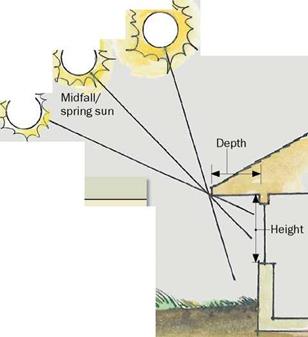Orient the House to the Sun
![]()
![]()
 Placing the long side of a house along the east – west axis exposes the south elevation to year – round light and warmth. In summer, this orientation minimizes overheating on the short east and west elevations. Grouping private and unoccupied spaces on the north side of the house, where they act as insulators for the south-facing public Bedroom rooms, maximizes the benefit of southern exposure.
Placing the long side of a house along the east – west axis exposes the south elevation to year – round light and warmth. In summer, this orientation minimizes overheating on the short east and west elevations. Grouping private and unoccupied spaces on the north side of the house, where they act as insulators for the south-facing public Bedroom rooms, maximizes the benefit of southern exposure.
North
Finding True North

![]() At the bottom margin of U. S. Geological Survey maps, there are three north bearings: magnetic north, true north, and grid north Magnetic north is compass-needle north, but it’s not helpful for solar siting, which calls for true north, indicated by the star. The difference between these bearings is the declination, in this case,
At the bottom margin of U. S. Geological Survey maps, there are three north bearings: magnetic north, true north, and grid north Magnetic north is compass-needle north, but it’s not helpful for solar siting, which calls for true north, indicated by the star. The difference between these bearings is the declination, in this case,
13.5 degrees.
from the rest of the house), much like the closed airspace in a thermos keeps the cold air outside from cooling the warm liquid inside.
Hillside Lots Are Cooler, So Plan Accordingly
Donald Trump once said that the three most important considerations when buying real estate are location, location, and location.
I doubt that he was referring to the potential for lower heating and cooling costs, but a house’s location on a piece of land can make it less expensive to heat and cool.
If you’re considering building on a hillside, for example, locate the house according to its most appropriate zone. In cold or temperate climates, it’s best to locate a house midway between the ridge and the valley.
There, the house is not exposed to increased wind velocities at the ridge or to subsiding cold air that settles at the valley bottom.
In hot, humid climates—the Gulf Coast states and the Southeast—ridges generally provide the most exposure to year-round cooling breezes. In hot, arid climates such as the Desert Southwest, valley floors tend to collect cold air overnight that helps to cool a house. You can trap this cold air by opening doors and windows at night and by closing them during the day.
Building on a south-facing slope, or aspect, of a landform increases the exposure of the house and surrounding grounds to the low-angle rays of the sun during the winter. In cold and temperate climates especially, you should avoid north-facing aspects whenever possible.
You should also take a good look at the adjacent area to the south of the building
Window Height ^ Shade Factor = The Right Overhang
![]()

 An effective window overhang shades summer sun but allows for winter-sun penetration. The overhang’s depth depends on the shade-line factor, ‘
An effective window overhang shades summer sun but allows for winter-sun penetration. The overhang’s depth depends on the shade-line factor, ‘
determined by the house’s geographic latitude and the direction the window faces. See the chart below, and also measure the overhang’s – height above the windowsill; then plug those numbers into the equation above to get the overhang’s ideal depth.
SHADE-LINE FACTORS
 Latitude in Degrees
Latitude in Degrees
|
Faces |
25 |
30 |
35 |
40 |
45 |
50 |
55 |
|
East |
0.8 |
0.8 |
0.8 |
0.8 |
0.8 |
0.8 |
0.8 |
|
Southeast |
1.9 |
1.6 |
1.4 |
1.3 |
1.1 |
1.0 |
0.9 |
|
South |
10.1 |
5.4 |
3.6 |
2.6 |
2.0 |
1.7 |
1.4 |
|
Southwest |
1.9 |
1.6 |
1.4 |
1.3 |
1.1 |
1.0 |
0.8 |
|
West |
0.8 |
0.8 |
0.8 |
0.8 |
0.8 |
0.8 |
0.8 |
site. Avoid building on areas that will be shaded during winter by tall buildings, coniferous trees, or landforms (ridges, etc.).
If you’re in a cold or temperate climate, where it’s best to build midway along the hillside rather than at the ridge or in the valley, you should study the contours of the hillside. Any natural drainages or depressions in the topography are poor choices for a building site (see the drawing on p. 132). A natural drainage or depression channels cold air down the hillside. This cold air collects behind obstructions to its natural flow, so a house should be built away from these cold – air flows. If you simply cannot follow this strategy, use evergreen vegetation or solid fencing to divert cold air around and away from the house.
Whenever possible, recess the north, east, and west sides of the house into the natural slope of the site, or pile soil against the house on these sides. These earth-berming
strategies provide additional, permanent insulation against both winter winds and summer overheating.
Earth-berming strategies require careful detailing to prevent water damage to the structure. They are generally more expensive than typical aboveground construction. When properly done, however, earth berm – ing provides long-term, low-maintenance energy savings.
If you are not familiar with earth-berming strategies but have a site that is suitable, consult an architect or a designer experienced in this type of construction.






Leave a reply